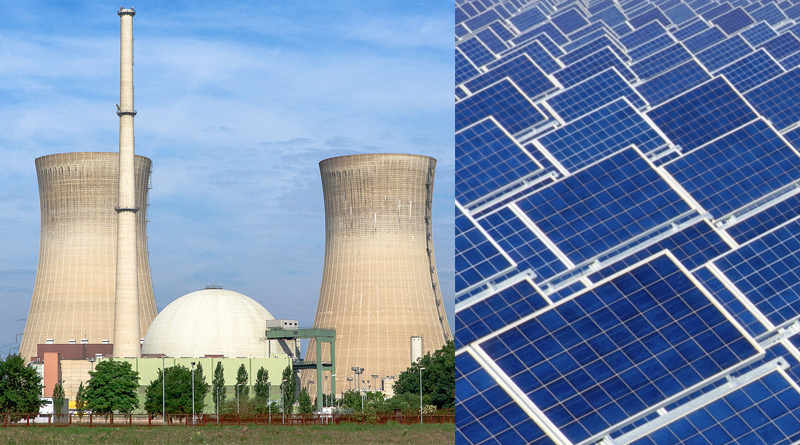Forget the Bush-Manmohan Singh vision of a nuclear power renaissance. Recent developments -cheap solar power plus the bankruptcy of Westinghouse -call for a total overhaul of nuclear plans that now look obsolete, dangerous and ultra-costly .
I say this as one who solidly supported the BushManmohan deal in 2005. That deal lifted sanctions against India, and provided access to imported uranium and nuclear technology . In return, the US, France, Japan and Russia were to build six nuclear plants each in India, reviving their flagging equipment industries.
In 2005, the nuclear industry expected a boom following global concerns on greenhouse gases. Nuclear power then was costlier than coal-based power but much cheaper than solar. With many nations going big on nuclear, scale economies plus thirdgeneration technology promised to make nuclear power as cheap as thermal power, minus the carbon.
Then came the Fukushima disaster in Japan.This highlighted the nuclear power risks. It led to the closure of old nuclear plants and cancellation of new ones across the world. The disappearance of mass orders killed scale economies for equipment, while new safety concerns led to expensive re-design.
Meanwhile 3G technology flopped in the power stations France\’s Areva was building in Finland and Normandy , causing huge cost and time overruns. Areva sank financially , and was rescued by EDF of France. But EDF itself was financially stressed and could not find the equity capital for a contracted nuclear station at Hinkley Point, UK.That project was saved when China Nuclear Electric agreed to take a 33% stake. The project will supply power at Rs 8unit, double the current wholesale price, amidst widespread criticism. Westinghouse, owned by Japan\’s Toshiba, has suffered huge time-cost overruns at two US plants and declared bankruptcy . Toshiba will suffer a net loss of $9.9 billion this year, and is quitting nuclear construction. If the bankrupt rump of Westinghouse finds no buyer or a non-Japanese buyer, India\’s political obligation to buy its equipment disappears.
During the parliamentary debate on the BushManmohan deal, the government claimed that nuclear power would cost no more than coalbased power, which was Rs 2.50unit then. Today it is Rs 4unit. Can foreign nuclear suppliers match this? No. Aniruddh Mohan of the Observer Research Foundation says the two new Russian reactors, Kudankulam 3 and 4, have a negotiated tariff of Rs 6.30unit. He estimates tariffs will be Rs 9 for Westinghouse and Rs 12 for Areva. News reports say India seeks to cap the Areva tariff at Rs 7unit.
These tariffs look insanely costly compared with the latest solar power deal of Rs 2.62unit in Rajasthan. This price cloaks implicit subsidies like cheap land, accelerated depreciation, and hidden costs for transmission and the backing down of thermal plants. But nuclear power also gets cheap land, cheap insurance (a huge subsidy) and guaranteed offtake.
Besides, the price of solar power keeps falling, and could halve again. New N-plants could take 8-10 years to build, by which time solar power may cost just Rs 1.50unit, and storage costs may fall below Rs 1unit. It is crazy to build nuclear plants producing power several times costlier. The solar revolution means that, a decade hence, other forms of power will be needed mainly for peak evening demand.Nuclear power is totally unsuitable for peaking.
Now, the nuclear deal implicitly obliged India to buy nuclear plants from the four foreign powers. But at the time, these were supposed to be competitive with thermal power. That\’s now a pipedream.
To avoid gargantuan financial losses, India needs to exit these foreign deals if at all possible.Diplomacy mandates that India cannot renege sim ply because solar power has become cheap. But India can demand that suppliers stick to the original idea of thermal price parity . If they cannot -as is the case -India should politely excuse itself, saying it can live up to its side of the implicit deal only if foreign suppliers live up to theirs.
General Electric of the US has anyway opted out of Indian nuclear plants, saying Indian liability limits for accidents are insufficient. If Westinghouse finds no buyer, or a non-Japanese buyer, India can scrap that deal. For Areva and future Russian plants, India should insist on thermal price equivalence, even if it sinks those deals.
India\’s indigenous nuclear power plants are the cheapest, at Rs 5unit. If fixed for 25 years, this is competitive with coal and less polluting.We need a fresh 10-year plan to create an optimal mix of solar, thermal, and nuclear power.


